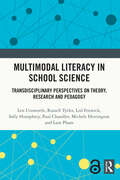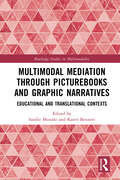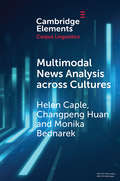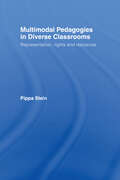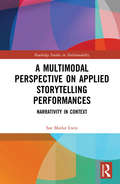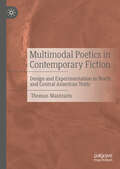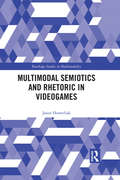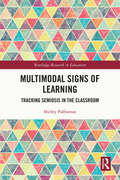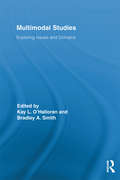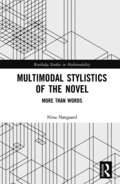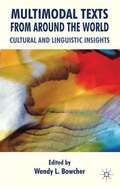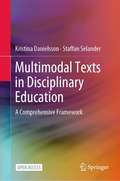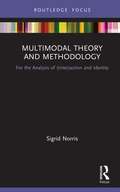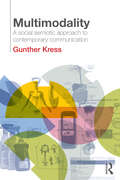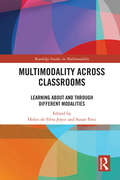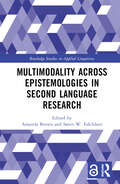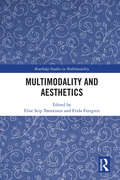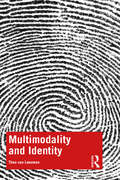- Table View
- List View
Multimodal Literacies Across Digital Learning Contexts (Routledge Studies in Multimodality)
by Maria Grazia Sindoni and Ilaria MoschiniThis collection critically considers the question of how learning and teaching should be conceived, understood, and approached in light of the changing nature of learning scenarios and new pedagogies in this current age of multimodal digital texts, practices, and communities. The book takes the concept of digital artifacts as being composed of multiple meaning-making semiotic resources, such as visuals, music, and design, as its point of departure to explore how diverse communities interact with these tools and develop and explore their understanding of digital practices in learning contexts. The first section of the volume examines different case studies in which involved participants learn to grapple with the introduction of digital tools for learning in children’s early years of schooling. The second section extends the focus to secondary and higher education settings as digital learning tools grow more complex as do students, parents, and teachers’ interactions with them and the subsequent need for new pedagogies to rethink these multimodal artifacts. A final section reflects on the implications of new multimodal tools, technologies, and pedagogies for teachers, such as on teacher training and community building among educators. In its in-depth look at multimodal approaches to learning as meaning-making in a digital world, this book will be of interest to students and scholars in multimodality, English language teaching, digital communication, and education.
Multimodal Literacies Across Digital Learning Contexts (Routledge Studies in Multimodality)
by Maria Grazia Sindoni and Ilaria MoschiniThis collection critically considers the question of how learning and teaching should be conceived, understood, and approached in light of the changing nature of learning scenarios and new pedagogies in this current age of multimodal digital texts, practices, and communities.The book takes the concept of digital artifacts as being composed of multiple meaning-making semiotic resources, such as visuals, music, and design, as its point of departure to explore how diverse communities interact with these tools and develop and explore their understanding of digital practices in learning contexts. The first section of the volume examines different case studies in which involved participants learn to grapple with the introduction of digital tools for learning in children’s early years of schooling. The second section extends the focus to secondary and higher education settings as digital learning tools grow more complex as do students, parents, and teachers’ interactions with them and the subsequent need for new pedagogies to rethink these multimodal artifacts. A final section reflects on the implications of new multimodal tools, technologies, and pedagogies for teachers, such as on teacher training and community building among educators.In its in-depth look at multimodal approaches to learning as meaning-making in a digital world, this book will be of interest to students and scholars in multimodality, English language teaching, digital communication, and education.
Multimodal Literacy in School Science: Transdisciplinary Perspectives on Theory, Research and Pedagogy
by Len Unsworth Russell Tytler Lisl Fenwick Sally Humphrey Paul Chandler Michele Herrington Lam PhamThis book establishes a new theoretical and practical framework for multimodal disciplinary literacy (MDL) fused with the subject-specific science pedagogies of senior high school biology, chemistry and physics. It builds a compatible alignment of multiple representation and representation construction approaches to science pedagogy with the social semiotic, systemic functional linguistic-based approaches to explicit teaching of disciplinary literacy. The early part of the book explicates the transdisciplinary negotiated theoretical underpinning of the MDL framework, followed by the research-informed repertoire of learning experiences that are then articulated into a comprehensive framework of options for the planning of classroom work. Practical adoption and adaptation of the framework in biology, chemistry and physics classrooms are detailed in separate chapters. The latter chapters indicate the impact of the collaborative research on teachers' professional learning and students’ multimodal disciplinary literacy engagement, concluding with proposals for accommodating emerging developments in MDL in an ever-changing digital communication world. The MDL framework is designed to enable teachers to develop all students' disciplinary literacy competencies. This book will be of interest to researchers, teacher educators and postgraduate students in the field of science education. It will also have appeal to those in literacy education and social semiotics.
Multimodal Mediation Through Picturebooks and Graphic Narratives: Educational and Translational Contexts (Routledge Studies in Multimodality)
by Sandie Mourão Karen BennettThis collection critically examines the notion of mediation as it manifests itself at the intersection of multimodal literature, education, and translation studies, bringing together perspectives from established and early career scholars.The volume seeks to synthesize the fields of education and translation by exploring points of difference and commonality through multimodal communication, which has grown increasingly crucial in both fields, and how these intersect in picturebooks and graphic narratives, including graphic novels, illustrated books, and other related genres. The book begins with considerations on the multimodal as mediator and how multimodal forms mediate their messages for educational contexts. Next, the exploration of translation as mediation and mediation as translation contemplates the ways in which picturebooks serve as intersemiotic translations of previously verbal texts and as a means of translating abstract concepts into tangible forms. Finally, there is a showcase of empirical research on the mediation of multimodal literature in diverse education settings from around the world. Taken together, the collection makes the case for further study of mediation and multimodality as a valuable concept for advancing research in translation and education.This book will be of particular interest to students and scholars in multimodality, children’s literature, translation studies, and educational research.
Multimodal News Analysis across Cultures (Elements in Corpus Linguistics)
by Helen Caple Changpeng Huan Monika BednarekCorpus-based discourse analysts are becoming increasingly interested in the incorporation of non-linguistic data, for example through corpus-assisted multimodal discourse analysis. This Element applies this new approach in relation to how news values are discursively constructed through language and photographs. Using case studies of news from China and Australia, the Element presents a cross-linguistic comparison of news values in national day reporting. Discursive news values analysis (DNVA) has so far been mainly applied to English-language data. This Element offers a new investigation of Chinese DNVA and provides momentum to scholars around the world who are already adopting DNVA to their local contexts. With its focus on national days across two very different cultures, the Element also contributes to research on national identity and cross-linguistic corpus linguistics.
Multimodal Pedagogies in Diverse Classrooms: Representation, Rights and Resources
by Pippa SteinMultimodal Pedagogies in Diverse Classrooms examines how the classroom can become a democratic space founded on the integration of different histories, modes of representation, feelings, languages and discourses, and is essential reading for anyone interested in the connection between multimodality, pedagogy, democracy and social justice in diverse classrooms. Pippa Stein combines theory with material taken from post-apartheid classrooms in South Africa where students from different language and cultural backgrounds negotiate the ongoing tensions between tradition and modernity, Western and African intellectual thought, as well as the apartheid-past of their parents, and their own aspirations for the future. This insightful book argues that classrooms can become ‘transformative’ sites in which students can develop curricula and pedagogies which speak to the diversity of global societies, and looks at: How multimodality can be used to promote social justice and democracy in diverse classrooms; The forms of representation through which students make meaning in classrooms; How those forms contribute to the building of democratic cultures; The cultural resources available to students, and how they are used for learning; Difference as a productive energy for learning. Dealing with issues such as democracy, politics of difference, diversity, multicultural and multilingual classrooms, this book is as pertinent to readers across the globe as it is to those in South Africa, and will be invaluable and fascinating reading for anyone working or interested in this field.
A Multimodal Perspective on Applied Storytelling Performances: Narrativity in Context (Routledge Studies in Multimodality)
by Soe Marlar LwinIn this volume, Soe Marlar Lwin proposes a contextualized multimodal framework that brings together storytelling practitioners’ and academic researchers’ conceptions of storytelling. It aims to highlight the ways in which various institutions in contemporary society have been using live storytelling performances as an effective communicative, educative and meaning-making tool. Drawing on theories of narrative from narratology as well as from related fields such as discourse analysis, multimodal analysis, communication and performance studies, the author proposes a contextualized multimodal framework to (a) uncover the potential narrativity of a live storytelling performance through an analysis of narrative elements constituting the story, (b) capture the process of developing actual narrativity through a multimodal analysis of performance features in the storytelling discourse, and (c) highlight the importance of context and dynamics between the storyteller and audience for an achievement of optimal narrativity in a particular storytelling event. The sample analysis shows how the framework not only describes the system governing institutionalized storytelling performances in general but also serves as a useful model to examine individual performance as a unique realization of the general system. The book also offers implications for possible applications of such contextualized multimodal frameworks more broadly across the disciplines.
Multimodal Poetics in Contemporary Fiction: Design and Experimentation in North and Central American Texts
by Thomas MantzarisThis book explores the growing body of multimodal literary texts: books that creatively experiment with the potential of design to represent narrative content. Examining five North and Central American novels from the first two decades of the twenty-first century, this study draws attention to texts that combine verbal text (writing) with non-verbal elements (photographic images, varied typography, maps, color, etc.) as integral parts of their narratives. Their experimentation both reconfigures the potential for print-based (and born-digital) fiction in the future, and holds a mirror to past practices of design and typography that were rendered invisible, or which received limited attention by authors, publishers, and readers. By placing the five case studies and related texts within a broader history of experimentation in literature, this book demonstrates how multimodal novels have changed the conceptualization of narrative content in literary texts and ushered in a new era for fiction.
Multimodal Semiotics and Rhetoric in Videogames (Routledge Studies in Multimodality)
by Jason HawreliakThis book merges recent trends in game studies and multimodal studies to explore the relationship between the interaction between videogames’ different modes and the ways in which they inform meaning for both players and designers. The volume begins by laying the foundation for integrating the two disciplines, drawing upon social semiotic and discourse analytic traditions to examine their relationship with meaning in videogames. The book uses a wide range of games as examples to demonstrate the medium’s various forms of expression at work, including audio, visual, textual, haptic, and procedural modes, with a particular focus on the procedural form, which emphasizes processes and causal relationships, to better showcase its link with meaning-making. The second half of the book engages in a discussion of different multimodal configurations and user generated content to show how they contribute to the negotiation of meaning in the player experience, including their role in constructing and perpetuating persuasive messages and in driving interesting and unique player decisions in gameplay. Making the case for the benefits of multimodal approaches to game studies, this volume is key reading for students and researchers in multimodal studies, game studies, rhetoric, semiotics, and discourse analysis.
Multimodal Sentiment Analysis (Socio-Affective Computing #8)
by Soujanya Poria Amir Hussain Erik CambriaThis latest volume in the series, Socio-Affective Computing, presents a set of novel approaches to analyze opinionated videos and to extract sentiments and emotions. Textual sentiment analysis framework as discussed in this book contains a novel way of doing sentiment analysis by merging linguistics with machine learning. Fusing textual information with audio and visual cues is found to be extremely useful which improves text, audio and visual based unimodal sentiment analyzer. This volume covers the three main topics of: textual preprocessing and sentiment analysis methods; frameworks to process audio and visual data; and methods of textual, audio and visual features fusion. The inclusion of key visualization and case studies will enable readers to understand better these approaches. Aimed at the Natural Language Processing, Affective Computing and Artificial Intelligence audiences, this comprehensive volume will appeal to a wide readership and will help readers to understand key details on multimodal sentiment analysis.
Multimodal Signs of Learning: Tracking Semiosis in the Classroom (Routledge Research in Education)
by Shirley PalframanMultimodal Signs of Learning proposes a methodology to uncover evidence of learning in students’ multimodal compositions. Informed by social semiotic theory, the book tracks representation of subject content from physical and embodied teaching resources to students’ handmade artefacts and physical presentations. Using materials from secondary school history and science classrooms, multimodal realizations of specific representational processes are tracked from the input of resources through to the students’ multimodal compositions – their posters, models and physical presentations. Through tracking semiosis, the book exposes the epistemologies inherent in the representational choices articulated in the students’ multimodal designs. These, it is argued, are to be valued as signs of learning. Learning is thus characterized as ‘design’ and the transformation of subject content through representation in different modes shown not only to promote learning, but also to contain evidence for its recognition. The book raises important questions about what constitutes multimodal learning and how it can be applied. It contributes to the growing body of research into the changing dynamics of classrooms and assessment practices and will be of great interest to researchers, and academics in the fields of education research, multimodality, semiotics and communication.
Multimodal Studies: Exploring Issues and Domains (Routledge Studies in Multimodality)
by Kay L. O’Halloran Bradley A. Smith New YorkThe phenomenon of multimodality has, as Jewitt observes, generated interest "across many disciplines...against the backdrop of considerable social change." Contemporary societies are grappling with the social implications of the rapid increase in sophistication and range of multimodal practices, particularly within interactive digital media, so that the study of multimodality also becomes essential within an increasing range of practical domains. As a result of this increasing interest in multimodality, scholars, teachers and practitioners are on the one hand uncovering many different issues arising from its study, such as those of theory and methodology, while also exploring multimodality within an increasing range of domains. Such an increase and range of interest in multimodality heralds the emergence of a distinct multimodal studies field: as both the mapping of a domain of enquiry, and as the site of the development of theories, descriptions and methodologies specific to and adapted for the study of multimodality. The present volume presents a range of works by an impressive international roster of contributors who both explore issues arising from the study of multimodality and explore the scope of this emerging field within specific domains of multimodal phenomena. Contributors aim to show that each individual work and works in general within multimodal studies represent a dialectic or complementarity between the exploration of issues of general significance to multimodal studies and the exploration of specific domains of multimodality; while characterizing specific works as tending to some degree towards one or other of these main areas of focus. Such a characterization is seen as part of a move towards the identification and thus development of a distinct field of multimodal studies.
A Multimodal Stylistic Approach to Screen Adaptations of the Work of Alice Munro (Routledge Studies in Multimodality)
by Sabrina FrancesconiThis volume brings together perspectives from multimodal stylistics and adaptation studies for a unified theoretical analysis of adaptations of the work of Alice Munro, demonstrating the affordances of the approach in furthering interdisciplinary research at the intersection of these fields The book considers films and television programmes as complex multimodal stylistic systems in and of themselves in order to pave the way for a clearer understanding of screen adaptations as expressions of modal, medial, and aesthetic change. In focusing on Munro, Francesconi draws attention to a writer whose body of work has been adapted widely across television and film for an international market over several decades, offering a diachronic overview and insights into the confluence of socio-cultural contexts, audiences, and dynamics of production and distribution across adaptations. The volume complements this perspective with a microanalysis of the adaptations themselves, exploring the varied creative use of audio-visual dimensions, including sound, light, and movement. The book seeks to overcome simplified fidelity-based understandings of screen adaptations more broadly, showcasing creative multi-layered approaches to a creator’s oeuvre to effect true transformation across media and modes. The volume will be of interest to scholars in multimodality, adaptation studies, film studies, and comparative literature.
Multimodal Stylistics of the Novel: More than Words (Routledge Studies in Multimodality)
by Nina NørgaardThis book advocates for a new analytical framework that extends our understanding of multimodal meaning-making in the novel. Integrating theoretical traditions from stylistics and the influential social semiotic approach to multimodal communication developed by Kress and van Leeuwen, Nørgaard applies this method of analysis in order to build on existing stylistic practices that look at linguistic features in the novel to encompass other semiotic resources found in the form, such as typography, layout, images, paper and book-cover design. The volume grounds the discussion with supporting examples from novels that feature experimentation with multiple semiotic resources as well as more traditional novels, furthering the argument that all novels are inherently multimodal. Offering new insights and tools for unpacking multimodal meaning-making in this critical literary genre, this volume is an indispensable resource for graduate students and researchers in multimodality, stylistics and literary studies.
Multimodal Texts from Around the World
by Wendy L. BowcherA first in multimodal/multisemiotic discourse studies this collection of original articles by international scholars focuses primarily on texts from non-English speaking contexts. The illuminating insights enhance our understanding of how language and other semiotic resources construe specific cultural and social concerns.
Multimodal Texts in Disciplinary Education: A Comprehensive Framework
by Kristina Danielsson Staffan SelanderThis open access book provides an introduction to multimodality and the role of multimodal texts in today’s education. Presenting a comprehensive framework for analysing and working with multimodal texts in disciplinary education, it serves as a tool for researchers and teachers alike. The second part of the book focuses on sample analyses of a variety of educational texts for different age groups and from different disciplines, including games and online resources. The authors also comment on the specific challenges of each text, and how teachers can discuss such texts with their students to enhance both their understanding of the content and their multimodal literacy. The book is intended for researchers in fields like education and multimodal studies, and for teacher educators, regardless of school subject or age group. With the combined perspectives on text analysis and implications for education, the book addresses the needs of teachers who want to work with multimodal aspects of texts in education in informed ways, but lack the right tools for such work.
Multimodal Theory and Methodology: For the Analysis of (Inter)action and Identity (Routledge Focus on Linguistics)
by Sigrid NorrisThis concise guide outlines core theoretical and methodological developments of the growing field of Multimodal (Inter)action Analysis. The volume unpacks the foundational relationship between multimodality and language and the key concepts which underpin the analysis of multimodal action and interaction and the study of multimodal identity. A focused overview of each concept charts its historical development, reviews the essential literature, and outlines its underlying theoretical frameworks and how it links to analytical tools. Norris illustrates the concept in practice via the inclusion of examples and an image-based transcript, table, or graph. The book provides a succinct overview of the latest research developments in the field of Multimodal (Inter)action Analysis for early career scholars in the field as well as established researchers looking to stay up-to-date on core developments and learn more about a complementary approach to systemic functional and social semiotic frameworks.
Multimodality: A Social Semiotic Approach to Contemporary Communication
by Gunther KressThe 21st century is awash with ever more mixed and remixed images, writing, layout, sound, gesture, speech, and 3D objects. Multimodality looks beyond language and examines these multiple modes of communication and meaning making. Multimodality: A Social Semiotic Approach to Contemporary Communication represents a long-awaited and much anticipated addition to the study of multimodality from the scholar who pioneered and continues to play a decisive role in shaping the field. Written in an accessible manner and illustrated with a wealth of photos and illustrations to clearly demonstrate the points made, Multimodality: A Social Semiotic Approach to Contemporary Communication deliberately sets out to locate communication in the everyday, covering topics and issues not usually discussed in books of this kind, from traffic signs to mobile phones. In this book, Gunther Kress presents a contemporary, distinctive and widely applicable approach to communication. He provides the framework necessary for understanding the attempt to bring all modes of meaning-making together under one unified theoretical roof. This exploration of an increasingly vital area of language and communication studies will be of interest to advanced undergraduate and postgraduate students in the fields of English language and applied linguistics, media and communication studies and education.
Multimodality Across Classrooms: Learning About and Through Different Modalities (Routledge Studies in Multimodality)
by Helen de Silva Joyce Susan FeezThis volume takes a broad view of multimodality as it applies to a wide range of subject areas, curriculum design, and classroom processes to examine the ways in which multiple modes combine in contemporary classrooms and its subsequent impact on student learning. Grounded in a systemic functional linguistic framework and featuring contributions from scholars across educational and multimodal research, the book begins with a historical overview of multimodality’s place in Western education and then moves to a discussion of the challenges and rewards of integrating multimodal texts and ever-evolving technologies in a variety of settings, include primary, language, music, early childhood, Montessori, and online classrooms. As a state of the art of teaching and learning through different modalities in different educational contexts, this book is an indispensable resource for students and scholars in applied linguistics, multimodality, and language education.
Multimodality across Epistemologies in Second Language Research (Routledge Studies in Applied Linguistics)
by Amanda Brown and Søren W. EskildsenThis collection highlights diverse epistemological perspectives in original research on the important role of multimodality in second language contexts. The volume explores a wide range of theoretical and methodological traditions toward foregrounding the notion that bodily action is not merely an add-on to the modality of talk but an integral part of second language teaching, learning, and interaction. Following an introductory chapter, 18 empirical chapters feature either classroom or non-classroom research, which shed light on different dimensions of multimodality in second language contexts, including learning reflected in gesture, learning gesture across languages, the role of bodily action in language teaching, and the role of movement in configuring space for effective communication. Each empirical chapter follows a consistent structure detailing the research focus, the background to each study, methodology, and findings. A concluding synthesis chapter braids the insights of these chapters, drawing parallels across different methods, and pointing toward crosscutting areas for future research. This book will be of interest to students and scholars in applied linguistics, multilingualism, bilingualism, gesture studies, cognitive science, and psychology.Chapters 10 and 11 of this book are available for free in PDF format as Open Access at www.taylorfrancis.com. They has been made available under a Creative Commons Attribution-NonCommercial-ShareAlike (CC-BY-NC-SA) 4.0 International license.
Multimodality and Aesthetics (Routledge Studies in Multimodality)
by Elise Seip Tønnessen Frida ForsgrenThis volume explores the relationship between aesthetics and traditional multimodal communication to show how all semiotic resources, not just those situated within fine arts, have an aesthetic function. Bringing together contributions from an interdisciplinary group of researchers, the book meditates on the role of aesthetics in a broader range of semiotic resources, including urban spaces, blogs, digital scrapbooks, children’s literature, music, and online learning environments. The result is a comprehensive collection of new perspectives on how communication and aesthetics enrich and complement one another when meaning is made with semiotic resources, making this key reading for students and scholars in multimodality, fine arts, education studies, and visual culture.
Multimodality and Identity
by Theo van LeeuwenThis book brings together the work of leading theorist, Theo van Leeuwen, on typography, colour, texture, sound and movement, and shows how they are used to communicate identity, both corporate and individual. The book provides a detailed approach to analysing the key elements of multimodal style, and shows how these can be applied to a wide range of domains, including typography, product design, architecture, and animation films. Combining sociological insights into contemporary forms of identity with multimodal approaches to analysing how these identities are expressed, the text is richly illustrated with examples from fashion, the built environment, logos, modern art and more. With sample analyses, this user-friendly text provides clear methods for analysis and creative strategies for the practice of multimodal communication. Providing an invaluable toolkit to analysing the key elements of multimodal design and the way they work together, this book is essential reading for students, teachers and researchers in the field of multimodal communication, whether in communication studies, linguistics, design studies, media studies or the arts.
Multimodality and Social Interaction in Online and Offline Shopping (Routledge Studies in Multimodality)
by Gitte Rasmussen Theo van LeeuwenThis collection brings together social semiotic, ethnographic, and conversation analytic approaches to multimodality in global studies of shopping, drawing on the rich diversity of the latest multimodal methods to critically reflect on shopping as a cornerstone of contemporary social life. The volume explores shopping as an area of study in its own right, with the buying and selling of goods and services a fundamental part of the social and cultural life of human communities for centuries. The book looks at both online and offline shopping, examining it as both everyday multi-sensorial practice and its translation into the interactive text and imagery that comprise the online shopping experience, from London street markets to Japanese grocery shops to Danish supermarkets to worldwide online shopping sites. Highlighting the diversity of modern multimodal approaches through contributions from established scholars, the book critically surveys both the challenges and opportunities in the embodied interactions between buyers and sellers and how these points of connection have been translated and will continue to transform in the age of algorithms and emergent technologies. This book will appeal to students and scholars interested in multimodality, multimodal conversation analysis, social semiotics, social interaction, and retail studies.
Multimodality and Social Interaction in Online and Offline Shopping (Routledge Studies in Multimodality)
by Gitte Rasmussen Theo van LeeuwenThis collection brings together social semiotic, ethnographic, and conversation analytic approaches to multimodality in global studies of shopping, drawing on the rich diversity of the latest multimodal methods to critically reflect on shopping as a cornerstone of contemporary social life.The volume explores shopping as an area of study in its own right, with the buying and selling of goods and services a fundamental part of the social and cultural life of human communities for centuries. The book looks at both online and offline shopping, examining it as both everyday multi-sensorial practice and its translation into the interactive text and imagery that comprise the online shopping experience, from London street markets to Japanese grocery shops to Danish supermarkets to worldwide online shopping sites. Highlighting the diversity of modern multimodal approaches through contributions from established scholars, the book critically surveys both the challenges and opportunities in the embodied interactions between buyers and sellers and how these points of connection have been translated and will continue to transform in the age of algorithms and emergent technologies.This book will appeal to students and scholars interested in multimodality, multimodal conversation analysis, social semiotics, social interaction, and retail studies.
Multimodality and Social Semiosis: Communication, Meaning-Making, and Learning in the Work of Gunther Kress (Routledge Studies in Multimodality)
by Margit Böck Norbert PachlerGunther Kress, one of the founders of social semiotics and multimodality, has made lasting contributions to these fields through his work in semiotics and meaning-making; power and identity; agency, design, production; and pedagogy and learning; in varied sites of transformation. This book brings together leading scholars in a variety of disciplines, including social semiotics, pedagogy, linguistics, media and communication studies, new literacy studies, ethnography, academic literacy, literary criticism and, more recently, medical/clinical education, to examine and build upon his work. This disciplinary diversity is evidence of the ways in which Kress' work has influenced and been influenced by a wide range of academic work and intellectual endeavors and how it has been used to lay foundations for theory-building and concept development in a varied yet connected range of areas. The individual contributions to the book pick up the threads of the often collaborative work of the authors with Kress; they show how these approaches were subsequently developed and discuss what future trajectories the authors see for them.

